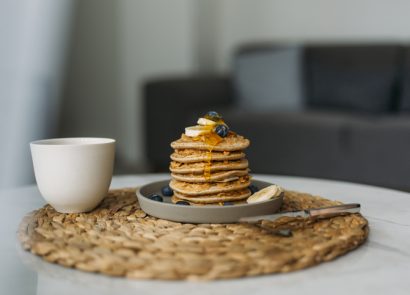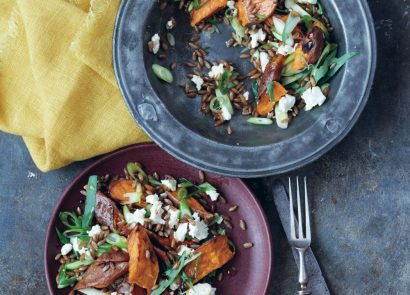In the UK, we spend an average of £60.60 on a family food shop every week* – and, this figure is likely to go up as food prices continue to soar. With average household spending also on the rise, it’s enough to get us all worrying about our bank balances. Luckily, there are some clever ways that you can reduce your supermarket checkout bill without making too many changes to your overall lifestyle – we’ve called in the experts to show us how.
Plan ahead
“It’s easy to pile up the trolley with food we think we may use, or get tempted by extras that we don’t need at all,” says weight loss consultant Dr Sally Norton (vavistalife.com). “We overdo it, and then throw lots away – in fact, we waste almost 200kg of food, per person, every year. Instead, spend time planning your healthier meals and buy exactly what you need. You could even purchase food online to avoid added temptation. Or, make sure you fill up on a healthy snack before you shop, to avoid buying more than you need.”
Buy in bulk
“I tend to buy things like oats, rice and whole wheat pasta in larger quantities,” says Aine Carlin, author of plant-based cookery books such as, The New Vegan (Kyle Books, £14.99). “Basics like these add texture with nuts and seeds. This is also a great way to ensure your meals are satisfy are a real lifesaver and especially useful when feeding a family. Making big batches of overnight oats, pasta or rice salad is not only a useful time-saver, but is easy on the pocket, too. Boost your dishes with a variety of seasonal fresh fruit or veg, and don’t forget toing and nutritious.”
Alternate your proteins
“Bulk out your meals with pulses and beans such as tinned chickpeas, lentils and cannellini beans – all of which you can buy canned,” says dietitian Harriet Smith (surreydietitian.co.uk). “You don’t need to cut out meat entirely when eating on a budget. A packet of mince, for example, can stretch to several meals, if you bulk it out with cheaper and wholesome ingredients, such as vegetables and pulses – try using 50 percent meat and 50 percent veg.”
Create a meal plan
“Making multiple different meals every evening can be costly and stressful,” adds Aine. “Why not compromise by having everyone’s favourite dish on selected days? Taco Tuesdays are always fun and allow you to be flexible with ingredients. Cauliflower is perennially affordable and super when broken into florets, coated in spices and roasted. Load it into soft flour tortillas, along with fresh rocket, avocado and a dollop of crème fraiche, for a seriously more-ish dinner.”
Say it with spuds
“Don’t underestimate the humble potato,” says Harriet. “This cheap and versatile vegetable is a good source of vitamin C – a large potato can provide as much as half of your vitamin C intake – plus potassium and starchy carbs for energy. Top it with some canned fish, mixed with natural yoghurt or mayonnaise and serve with salad. Or, you could serve it with baked beans, which is a good source of plant-based protein and fibre, topped with calcium-rich grated cheese for a nutritious and filling meal.
Shop local
“Steer clear of the supermarket with its aisles of expensive, processed food and head to your local butcher, fishmonger or green grocer,” advises Dr Sally. “You can buy what’s in season, locally sourced, in the quantity you need and without all the packaging. Plus, it’s often a fraction of the price. If you become a regular, you may be able to pick up older veg and meat bones for free – these are great for making hearty and healthy soups and stews.”
Choose frozen
“Fresh isn’t always best,” explains Harriet. “Frozen, tinned and juiced fruits and vegetables are often much cheaper than their fresh equivalents. Plus, there are some studies suggesting that frozen fruits and vegetables are more nutritious as they are frozen at the point of purchase, therefore retaining more of their vitamins and minerals.”
Cook from scratch
“Not only can you control what goes into your food and avoid the salt, sugar, bad fats and chemicals that make up much of the pre-prepared food on offer in the shops, cooking from scratch is also a much cheaper way to eat, as you aren’t paying for production and packing costs,” says Dr Sally. “And, with a little imagination and planning, leftovers can be made to last for a further meal or two. Until you try, you won’t believe how easy it is to make your own bread, yoghurt, soups, smoothies and much more.”
Make use of your freezer
“Freeze bread and pop a slice into the toaster as and when you need it,” advises Harriet. “This prevents your loaf from going mouldy and being thrown out as food waste.”
Grow your own
“OK, so you can’t get the full range of fruit and veg that you find in a supermarket, but it’s better to eat seasonally and avoid the carbon footprint of a pineapple flown from Costa Rica,” says Dr Sally. “Even a window box can produce some decent herbs to flavour salads and omelettes, a tub can be used for carrots, salad leaves or beetroot and a hanging basket can produce a great crop of cherry tomatoes. An allotment can be used to grow a whole lot more, as well as helping you to get some valuable exercise!” Want more ideas on growing your own produce? Visit growyourownfruitandveg.co.uk for tonnes of advice and suggestions.
Bake your own snacks
“Shop-bought treats are incredibly expensive, but in reality are very easy to make,” Aine tells us. “My ‘no-bake granola bars’ from my book are a great alternative and so simple that even the kids can get involved. Wrap individually in parchment paper and pack one in their lunchbox for a healthy, yet delicious midmorning pick-me-up, that’s sure to keep them going until lunch.”
Aine’s no-bake granola bars

Makes about 16
● 150g oats
● ½ tbsp maca powder (optional)
● 30g almonds, roughly chopped
● 30g sunflower seeds
● 30g pumpkin seeds
● 30g raisins
● 2 large medjool dates, chopped
● 30g desiccated coconut
● 30g chocolate chips
● 1 ripe banana
● 4 tbsp coconut oil, melted
● 3 tbsp peanut butter
● 2 tbsp cashew or almond butter
● 1 tsp vanilla extract
● 5 tbsp agave or maple syrup
● Pinch of salt
1. Mix all the dry ingredients in a bowl.
2. Mash the banana and whisk in the melted coconut oil, nut butters, vanilla extract and agave, until completely smooth. Pour over the granola mix and stir to combine.
3. Line a brownie tin and tip the sticky granola into it, flattening to the edges with the back of a spatula.
4. Refrigerate for at least 6 hours. Cut lengthways into long bars and then halve each one – you should get about 16 bars from each batch.
Tip:
Melt some dark chocolate chips and generously drizzle over the top before cutting. Refrigerate for about 30 minutes before serving.




















